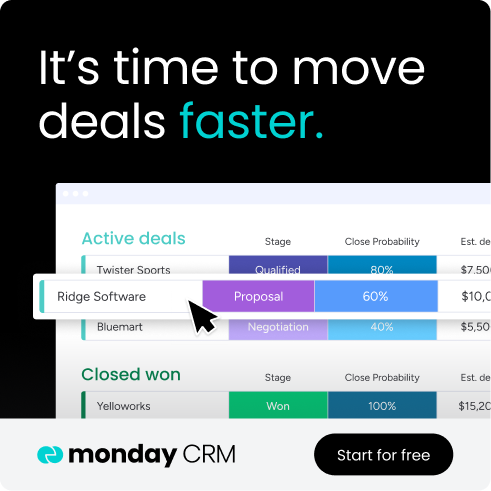Most sales teams generate a massive amount of data from calls, emails, and deal updates. Without a central system to organize it, this valuable information often becomes noise, leaving teams to rely on guesswork for forecasting and strategy. A unified platform like monday CRM is designed to solve this by bringing all sales activities into one visual workspace, giving everyone a shared, data-backed view of the pipeline.
This guide explores the best sales reporting software to help your team make data-backed decisions and win more deals. We will cover the key benefits of using a dedicated platform, the must-have features to look for, and a simple framework for choosing the right solution for your team’s needs. Let’s begin by defining what makes this software a game-changer for modern sales organizations.
What is sales reporting software
Sales reporting software functions as a central intelligence hub for your sales team. It organizes all the scattered operational data into visual dashboards, allowing you to see what’s working and where you need to adjust your strategy. This system replaces guesswork with data-backed decisions that lead to more wins.
This level of visibility provides everyone with a shared scoreboard, showing exactly where deals stand and highlighting opportunities for decisive action. You can instantly spot which reps are excelling and where others might need targeted coaching, ensuring no one gets left behind and the entire team moves in sync. It’s about turning raw data into a unified strategic plan.
Ultimately, this is how your team starts playing offense instead of defense. With powerful forecasting, you can predict future revenue with surprising accuracy, giving you the confidence to set ambitious but achievable goals. The process shifts from simply reacting to sales outcomes to proactively shaping them, making everyone faster, more aligned, and ready to succeed.
3 key benefits of sales reporting software
Sales reporting software transforms scattered data into a clear roadmap for closing more deals. Here are three game-changing benefits:
Complete pipeline visibility –> monday CRM delivers a real-time view of your entire pipeline on one dashboard, eliminating blind spots. Spot opportunities faster, address hurdles proactively, and make confident decisions with everyone aligned on what it takes to win.
Powerful coaching insights –> Pinpoint exactly where reps can improve and replicate what top performers do best. Identify skill gaps, celebrate wins, and create targeted development plans that elevate your entire team’s performance.
Time-saving automation –> Automate the busywork of tracking and reporting so your team can focus on building relationships and closing deals. Give your reps back hours each week for revenue-generating activities.
5 must-have features in sales reporting tools
The best sales reporting tools transform your CRM from a simple database into a strategic partner that reveals your clearest path to ‘closed-won.’ Consider these five features your non-negotiables for building a team that consistently exceeds its targets:
- Real-time dashboards: Live data visualization that updates instantly as your team makes changes, giving everyone an accurate view of pipeline health, deal progress, and team performance without manual refreshes or delays.
- Customizable reporting: Flexible report builders that let you create tailored views for different roles and objectives, from executive summaries to granular rep-level metrics, without requiring technical expertise or IT support.
- Predictive forecasting: AI-powered analytics that analyze historical patterns and current pipeline data to project future revenue with accuracy, helping you set realistic targets and identify potential shortfalls before they become problems.
- Performance tracking: Comprehensive metrics that measure individual and team success across key indicators like conversion rates, deal velocity, and quota attainment, making it easy to spot top performers and coaching opportunities.
- Seamless integrations: Native connections to your existing tech stack—from email and calendar tools to marketing platforms and communication apps—ensuring all your sales data flows into one unified system without manual data entry.
Top 10 sales reporting platforms for data-driven teams
The right sales reporting tool shows you a clear roadmap for success. We’ve assembled the top contenders below, each offering unique strengths for different team sizes and goals. Let’s find the platform that gives your team the visibility and control to consistently surpass your targets.
1. monday CRM
With its visual, no-code approach to pipeline management, monday CRM turns the often tedious process of sales reporting into a strategic advantage. The platform specializes in customizable dashboards and real-time insights, making it ideal for sales teams who want complete visibility without the complexity of traditional CRM systems.
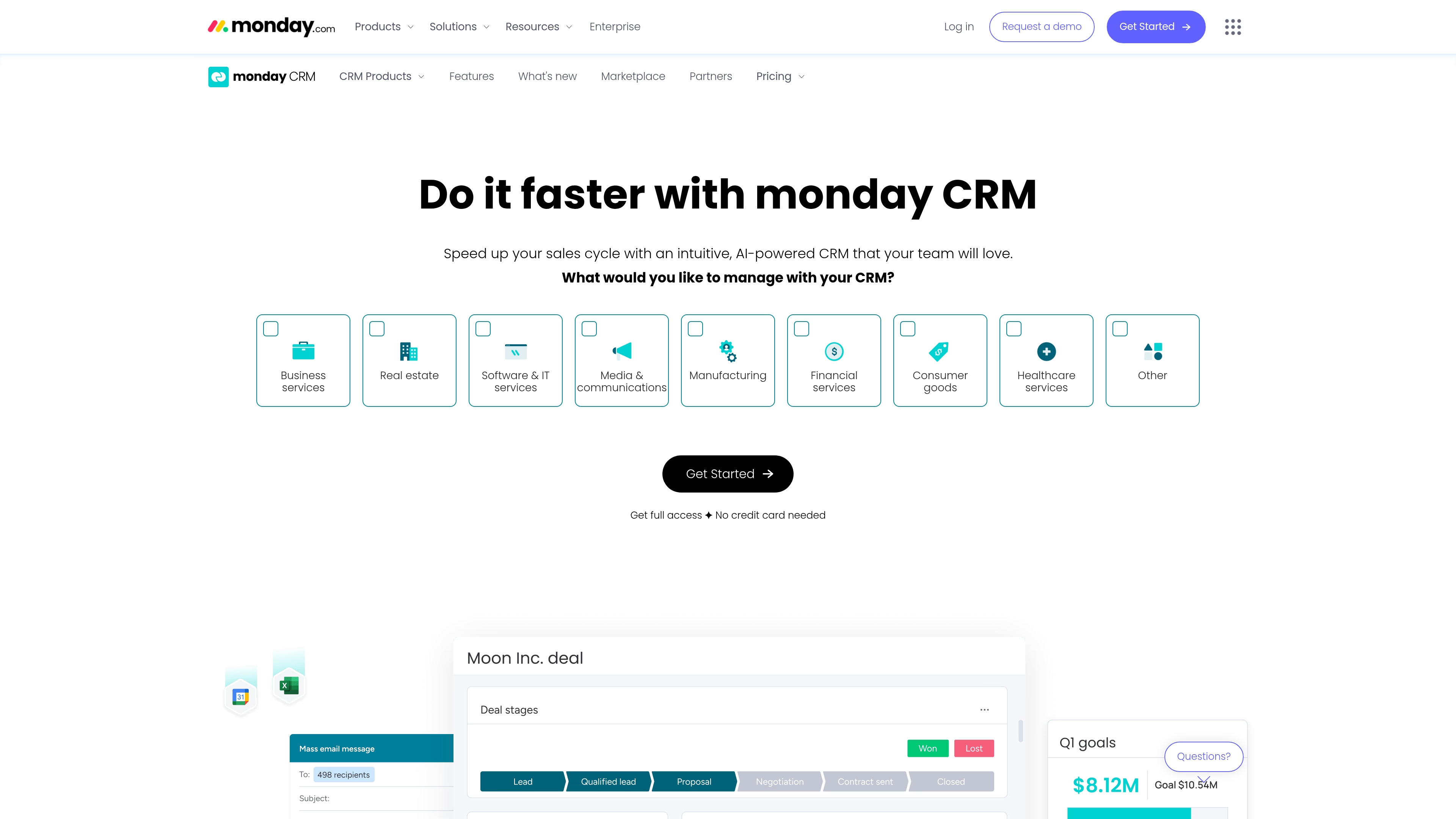 Example:
Example:
monday CRM consolidates all sales data into one visual platform, enabling teams to create custom reports, track pipeline health, and forecast revenue without needing technical expertise.
Key features:
- Customizable dashboards: Build visual reports with drag-and-drop widgets, funnel charts, and leaderboards that update in real-time.
- Automated board system: Pre-built boards for leads, accounts, contacts, deals, and activities that sync automatically when pipeline changes occur.
- 360° deal visibility: Track every opportunity with comprehensive client information, interaction history, and clear pipeline positioning.
Pricing:
- Free: $0 (up to 2 seats, 3 boards, 200+ templates, iOS & Android apps)
- Basic: $9/month per seat (billed annually, unlimited viewers & items, 5GB storage, prioritized support, trial AI credits)
- Standard: $12/month per seat (billed annually, timeline & Gantt views, 250 automations & integrations, guest access, trial AI credits)
- Pro: $19/month per seat (billed annually, private boards, time tracking, 25K automations, trial AI credits)
- Enterprise: Contact sales (portfolio management, advanced security & analytics, 250K automations, 24/7 priority support, trial AI credits)
Minimum of 3 users required. Plans are billed annually for an 18% savings, but monthly billing is also available. Nonprofit discounts are offered.
Why it stands out:
- Visual simplicity: Colorful, intuitive interface that makes complex sales data accessible to everyone on your team, not just data analysts.
- No-code flexibility: Build custom workflows and reports without technical skills, adapting the platform to your unique sales process.
- Work OS integration: Seamlessly connects with other monday.com products for cross-departmental visibility and unified project management.
Advanced AI features:
- Predictive forecasting: AI analyzes historical data and deal probabilities to project future revenue and identify at-risk opportunities.
- Smart task prioritization: AI suggests which deals to focus on based on close probability, deal size, and sales cycle stage.
- AI-assisted email composition: Let AI help you draft effective outreach and follow-up emails, saving you time on communication.
Automations:
- No-code recipe builder: Create custom automations with simple if-then logic to move deals, assign tasks, and update statuses automatically.
- Pre-built templates: Access ready-made automation recipes for common sales workflows like lead qualification and follow-up sequences.
- Enterprise-scale processing: Handle up to 250,000 automation actions per month on Enterprise plans for high-volume sales operations.
Integrations:
- Key CRM connections: Integrate with platforms like Salesforce and HubSpot to connect your workflows and centralize information.
- Communication tools: Connect with Gmail, Outlook, Microsoft Teams, and Twilio for seamless customer communication tracking.
- Marketing platforms: Integrate with Mailchimp and other marketing tools to track lead sources and campaign performance in your sales reports.
Sales reporting software features:
- Real-time pipeline tracking: Monitor deal progress, conversion rates, and team performance with dashboards that update instantly as your team makes changes.
- Funnel analysis: Visualize conversion rates at each stage of your sales process to identify bottlenecks and optimization opportunities.
- Performance leaderboards: Compare individual and team metrics across deal stages, revenue generated, and activity levels to drive healthy competition and coaching opportunities.
2. HubSpot
By unifying marketing and sales data within one powerful platform, HubSpot offers comprehensive sales reporting software that excels at user-friendly analytics. The solution is particularly well-suited for small to mid-size teams seeking actionable insights without a steep learning curve. With its generous free tier and seamless CRM integration, HubSpot removes barriers for businesses looking to adopt professional-grade sales reporting.
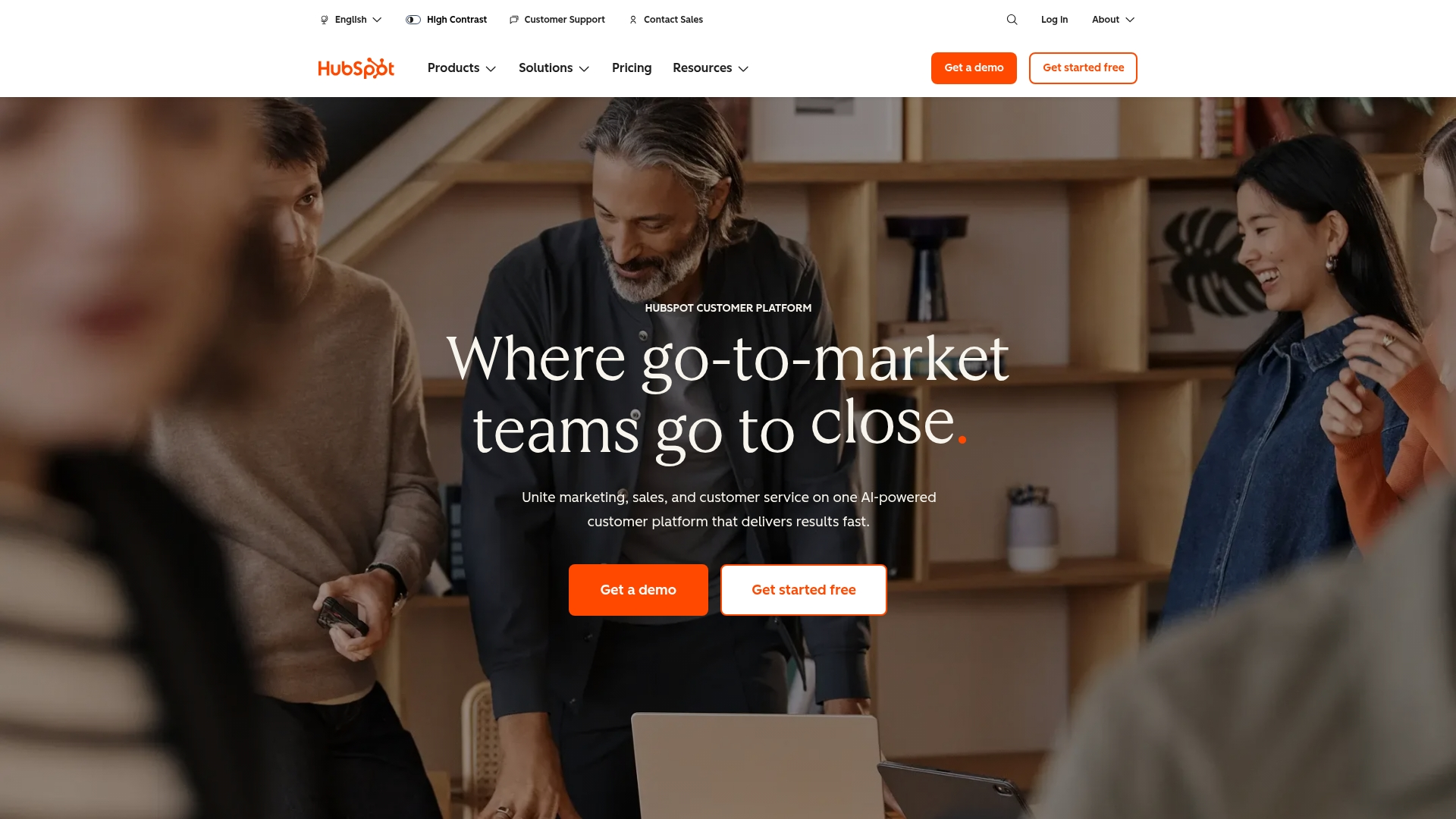 Use case:
Use case:
HubSpot’s sales reporting software provides real-time pipeline visibility and AI-powered forecasting to help sales teams track performance, identify coaching opportunities, and make data-driven decisions without requiring technical expertise.
Key features:
- Pre-built report library with dozens of out-of-the-box reports for deal forecasts, sales activities, and team performance tracking
- Custom report builder that allows cross-object reporting and AI-powered report descriptions for faster insights
- Sales analytics tool with waterfall reporting, pipeline revenue tracking, and deep coaching insights for managers
Pricing:
HubSpot offers a free CRM with basic reporting tools. Paid Sales Hub plans (Starter, Professional, and Enterprise) provide progressively advanced reporting, custom forecasting, and deeper analytics. For the most current pricing information, we recommend visiting the HubSpot website.
Considerations:
- Custom report limits on lower-tier plans can be restrictive for larger teams with extensive reporting needs
- Attribution reporting lacks the flexibility of specialized business intelligence tools, with limited multi-touch attribution customization options
3. Salesforce Sales Cloud
For large organizations managing complex sales operations, Salesforce Sales Cloud provides enterprise-level CRM capabilities with AI-powered analytics that transform raw sales data into strategic insights. The platform is built for comprehensive customization and real-time reporting, making it a powerful choice for companies operating across multiple teams and regions.
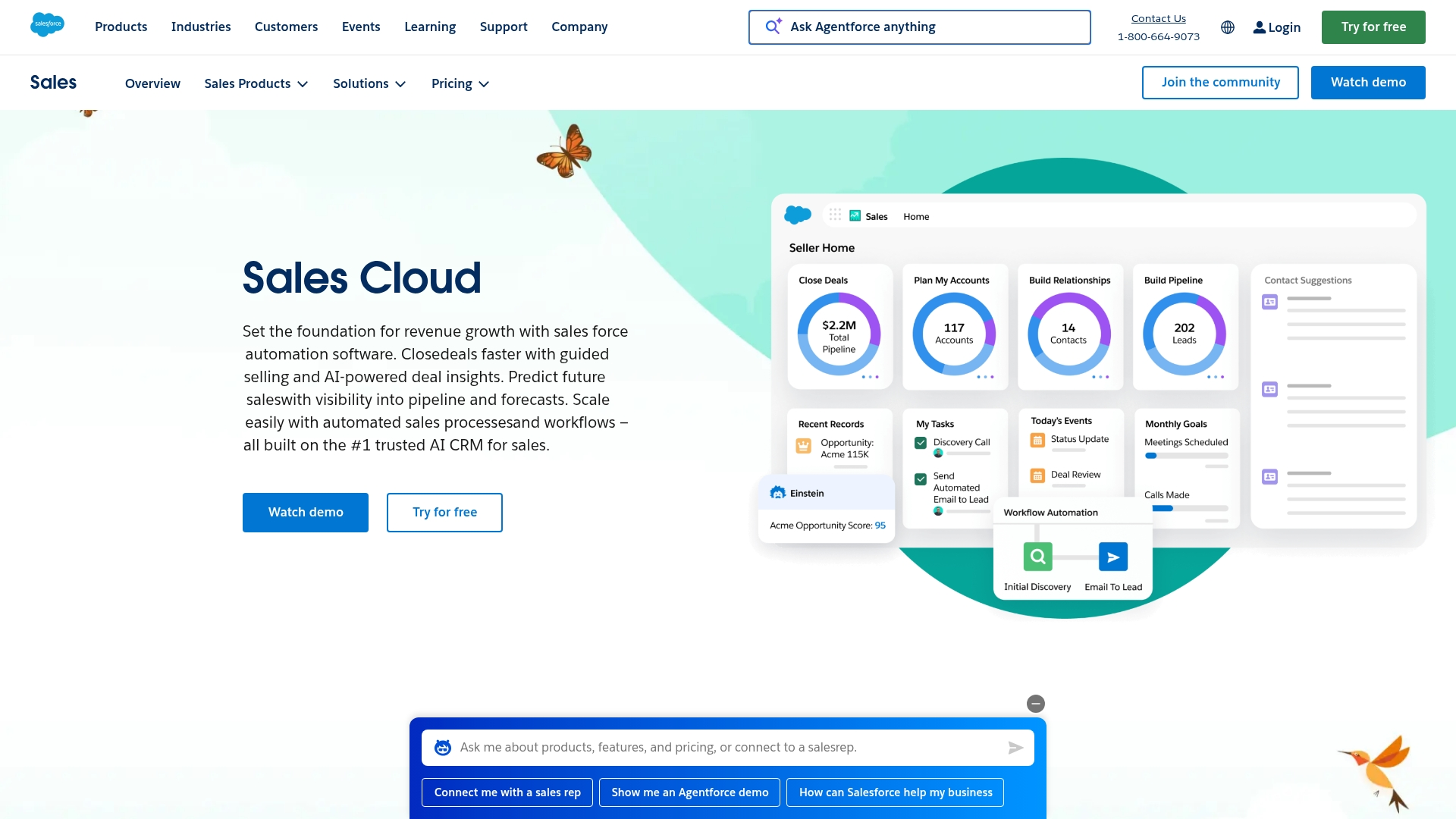 Use case:
Use case:
Salesforce Sales Cloud provides enterprise-grade sales reporting with Einstein AI integration, enabling large organizations to create custom dashboards, automate report generation, and gain predictive insights across their entire sales ecosystem.
Key features:
- Custom report builder: Drag-and-drop interface creates tabular, summary, matrix, and joined reports with real-time data visualization
- Einstein Analytics integration: AI-powered forecasting and predictive lead scoring uncover hidden trends and revenue opportunities
- Interactive dashboards: Dynamic filtering and role-based permissions deliver personalized insights for different organizational levels
Pricing:
Pricing information is not publicly available in the provided research. For detailed pricing, visit Salesforce’s pricing page or contact their sales team directly.
Considerations:
- Steep learning curve: Complex interface and advanced customization options often require specialized training or administrative support to maximize value
- Cost considerations: Enterprise-level pricing and implementation requirements may exceed budget constraints for smaller organizations
4. Pipedrive
Pipedrive is engineered to replace time-consuming spreadsheet management with visual, actionable insights that guide teams toward closing more deals. Created specifically for sales-focused teams, the platform’s Insights feature offers customizable dashboards and real-time analytics that make performance tracking effortless. This visual approach to sales data means your team spends less time wrestling with reports and more time building relationships that drive revenue.
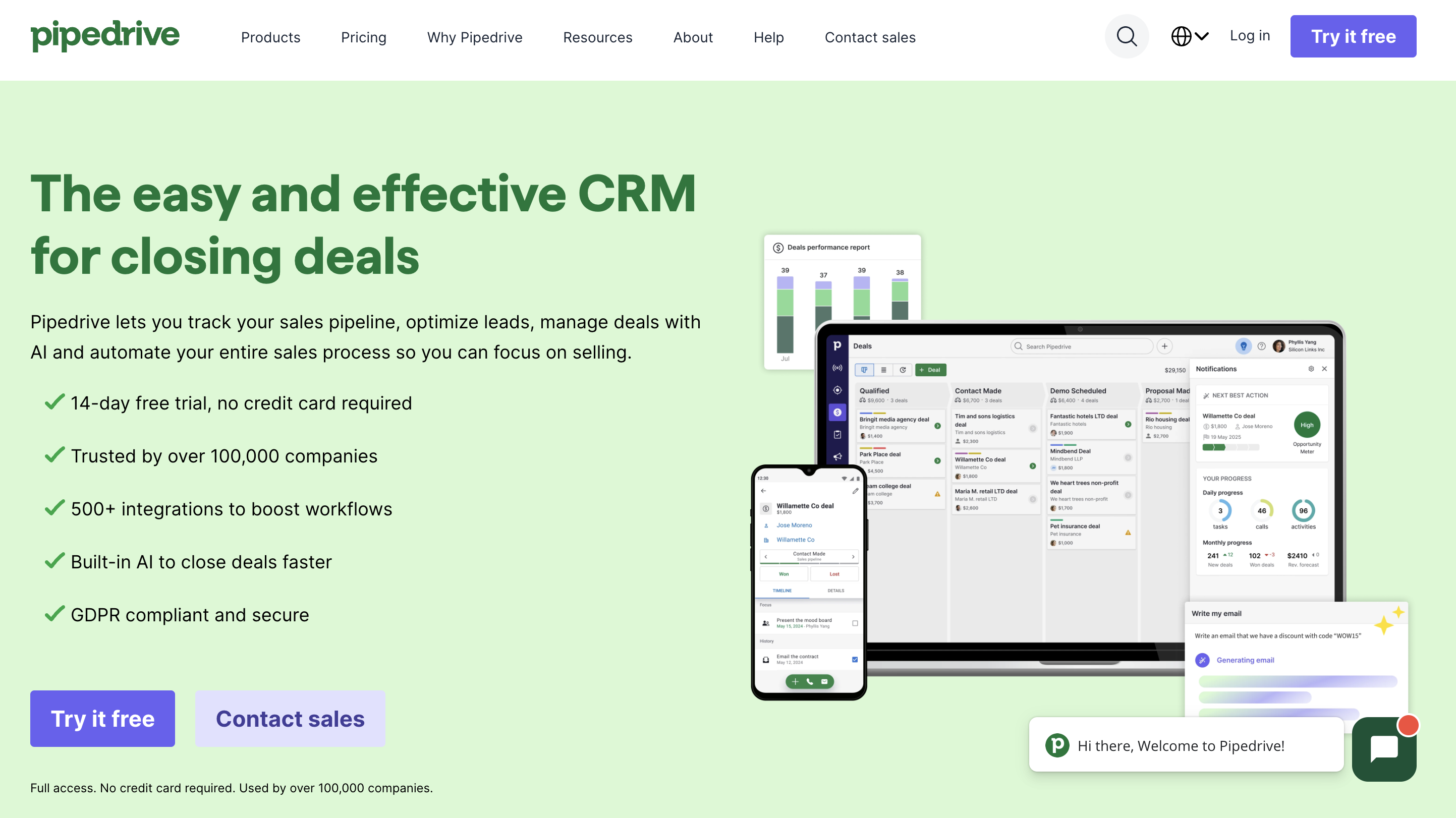 Use case:
Use case:
Pipedrive’s sales reporting software eliminates scattered spreadsheets by providing visual dashboards and customizable reports that help sales teams track performance, forecast revenue, and identify winning patterns in real-time.
Key features:
- Visual pipeline reports with drag-and-drop customization that show deal progress and conversion rates at a glance
- AI-powered Sales Assistant that provides predictive insights and win probability analysis for each deal
- Customizable dashboards with real-time KPI tracking including deals closed, average deal size, and team performance metrics
Pricing:
- Lite: $14/month (billed annually)
- Growth: $39/month (billed annually)
- Premium: $59/month (billed annually)
- Ultimate: $79/month (billed annually)
- Free 14-day trial available for all plans with no credit card required
- Add-ons available starting at $6.67/month per company
Considerations:
- Basic reporting features in lower-tier plans may feel limited for teams with complex analytics needs
- Advanced forecasting and detailed conversion reports require upgrading to higher-priced plans
5. Zoho CRM
Making enterprise-grade analytics accessible to growing businesses, Zoho CRM provides comprehensive sales reporting capabilities at an affordable price point. The platform specializes in AI-powered insights and seamless integration across Zoho’s entire business suite, making it a strong contender for cost-conscious teams seeking a unified data environment.
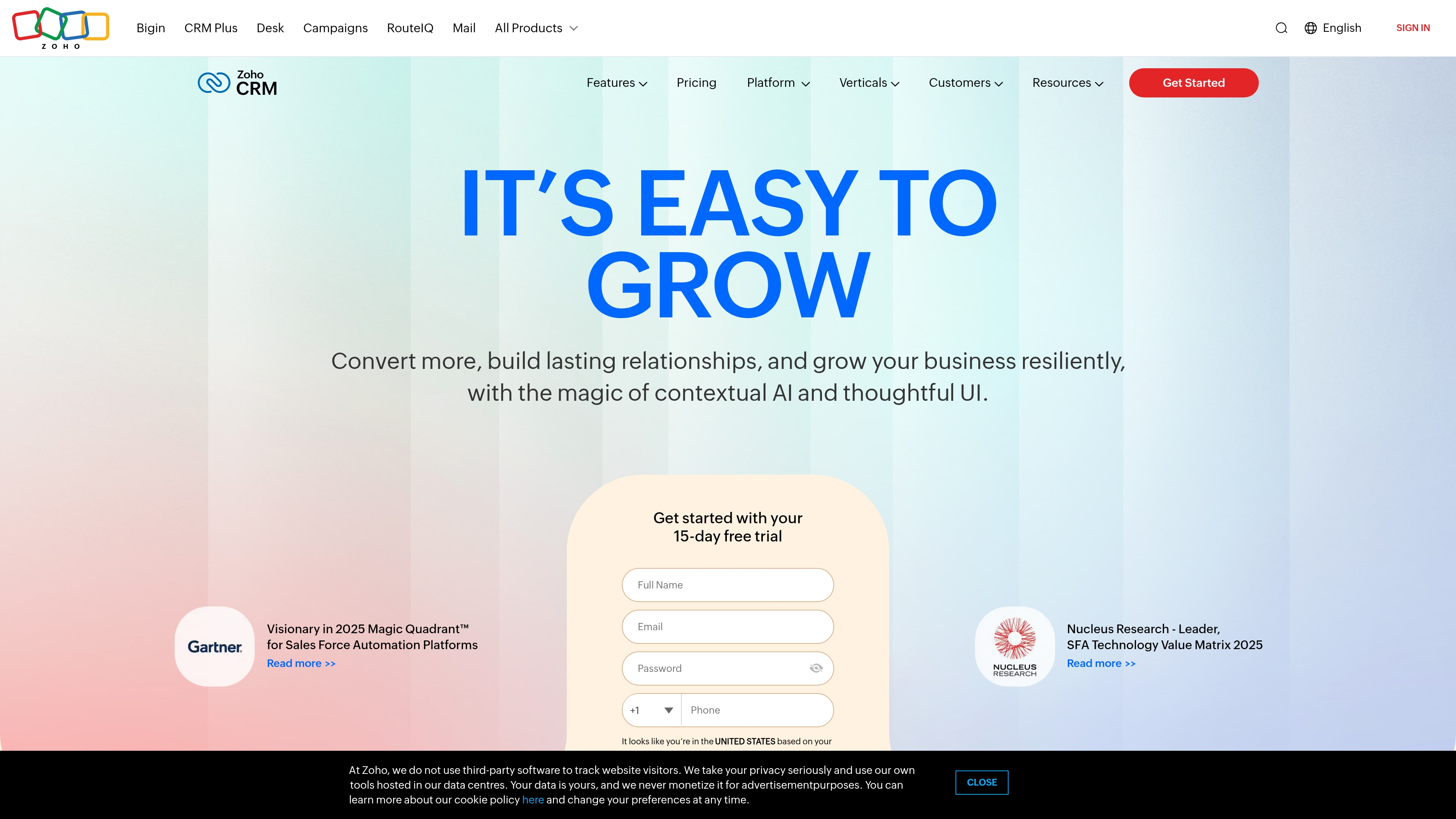 Use case:
Use case:
With dozens of pre-built reports, Zoho CRM transforms raw sales data into actionable insights, helping teams move from instinct-driven to data-driven decision-making.
Key features:
- AI-powered analytics with Zia: Provides predictive insights, anomaly detection, and intelligent recommendations to optimize sales performance.
- Cross-module reporting: Creates comprehensive reports that pull data from multiple Zoho applications for a holistic business view.
- Real-time pipeline analysis: Offers visual mapping of deals across pipeline stages with bottleneck identification and conversion rate tracking.
Pricing:
Pricing information for Zoho CRM was not available in the provided research content.
Considerations:
- The learning curve can be steep for new users due to the extensive range of reporting options and features.
- Advanced reporting capabilities are typically limited to higher-priced editions, with the free version offering basic functionality.
6. Databox
Databox specializes in consolidating scattered sales data into unified, automated reports, saving teams hours of manual compilation each week. The platform’s strength lies in multi-source data integration and professional visualization, making it a go-to for agencies and sales teams needing to merge performance metrics from tools like HubSpot, Salesforce, and Pipedrive into a single dashboard.
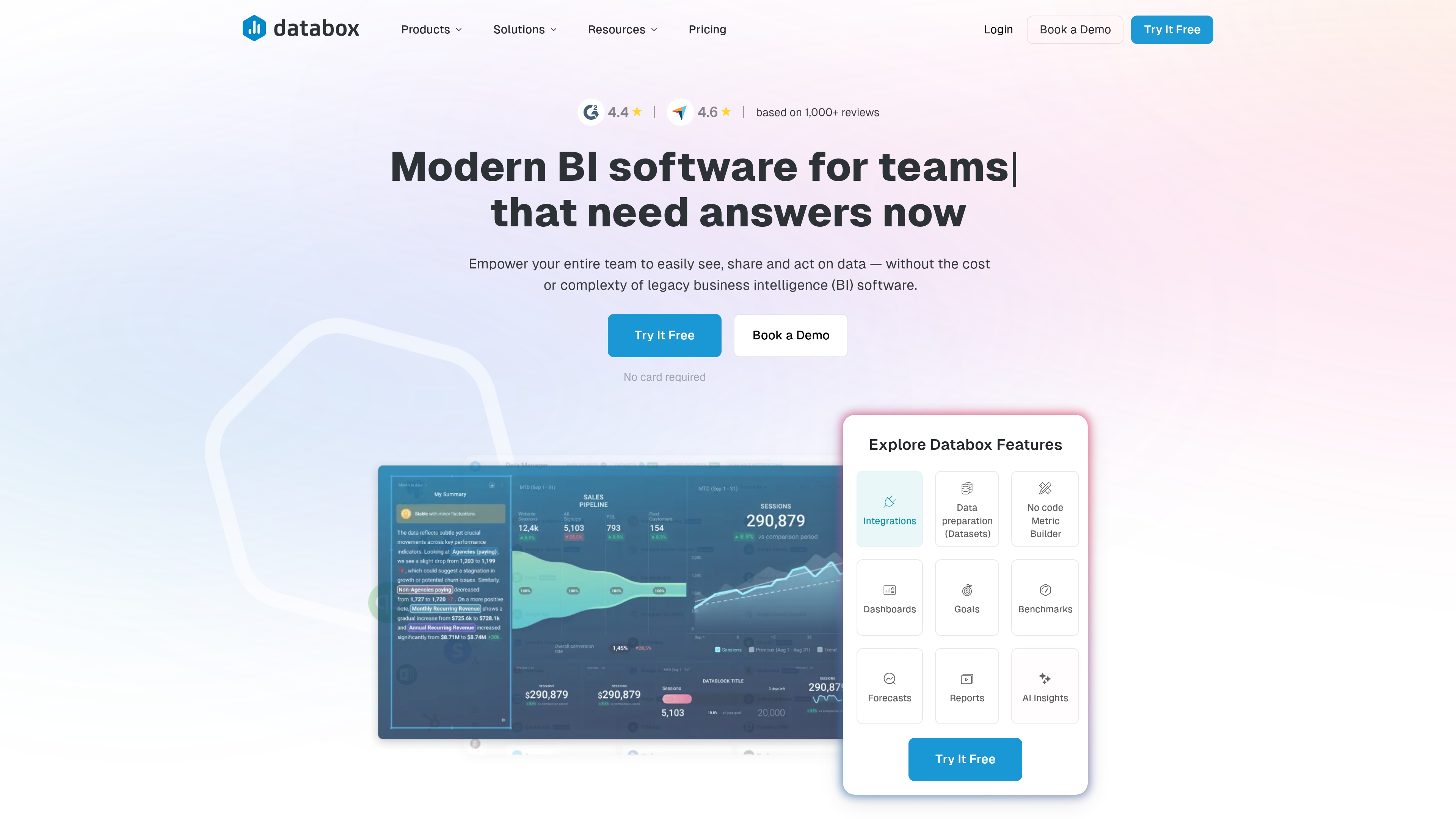 Use case:
Use case:
Databox consolidates sales data from over 130 sources into automated reports and dashboards, eliminating the need to manually compile metrics from multiple platforms.
Key features:
- Native integrations with major CRMs including HubSpot, Salesforce, and Pipedrive for seamless data consolidation
- Pre-built sales dashboard templates, customizable report formats, and automated “Data Stories” that turn insights into presentations
- Goal tracking with performance visualization, custom metric builder, and industry benchmarks to see how you stack up
- A dedicated mobile app to access your dashboards and performance alerts on the go
Pricing:
- Professional: $159/month (includes 3 data sources, unlimited users and dashboards)
- Growth: $399/month (includes 3 data sources, AI performance summaries, and benchmarks)
- Premium: $799/month (includes 100 data sources, forecasts, and a dedicated analyst)
- 20% discount available for annual billing
- 14-day free trial available for the Growth plan (no credit card required)
- Note: The free plan will be discontinued after July 1, 2025
- Additional data sources cost $5.60/month each
Considerations:
- Limited customization for complex, exploratory data analysis compared to more advanced BI tools
- Some users report a steep learning curve, occasional platform bugs, and delays in customer support
- Lacks support for HubSpot custom objects, which can be a limitation for teams heavily invested in that ecosystem
7. Looker
Through its proprietary LookML language, Looker establishes a single source of truth for sales data, delivering enterprise-grade business intelligence for data-heavy organizations. The platform’s focus on governed data modeling ensures that reporting remains consistent across teams. With deep Google Cloud integration and real-time analytics capabilities, Looker transforms how sales teams access and act on their performance data.
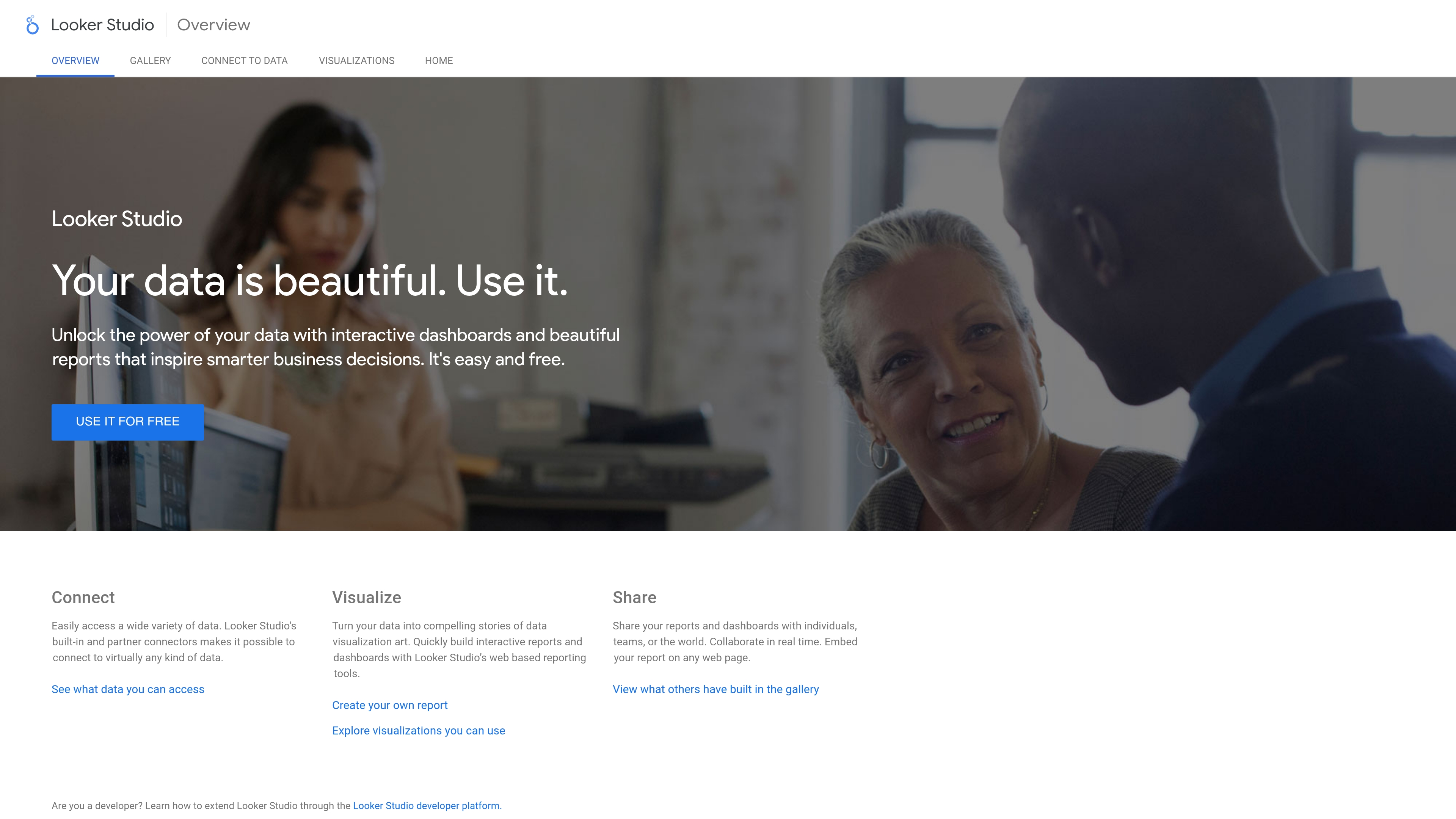 Use case:
Use case:
Looker empowers sales teams to build consistent, governed reporting frameworks that eliminate data discrepancies and provide real-time insights into pipeline health, forecasting, and team performance.
Key features:
- LookML semantic layer: Creates a centralized data model ensuring all sales metrics are defined consistently across the organization
- Data Actions integration: Enables sales reps to update CRM records, send emails, and trigger workflows directly from dashboards
- Real-time pipeline analytics: Connects directly to live databases for instant visibility into sales performance without data extraction delays
Pricing:
- Standard, Enterprise, and Embed editions: Custom pricing available through Google Cloud sales consultation
- Platform licensing: Includes one production instance, 10 Standard Users, and 2 Developer Users per edition
- User-based pricing: Additional costs for Developer, Standard, and Viewer user licenses with varying access levels
- Annual commitments: Available in one, two, and three-year terms with no published pricing
Considerations:
- Steep learning curve for LookML requires technical expertise, often creating dependency on data teams for report modifications
- Premium pricing model without public rates can be cost-prohibitive for smaller sales organizations
8. Zendesk Sell
A focus on simplicity and unified customer management defines the sales reporting software within Zendesk Sell. The platform excels at creating a seamless integration between sales and support data, making it a practical choice for small to mid-sized businesses seeking streamlined CRM functionality. However, it’s important to note that Zendesk Sell will be retired on August 31, 2027, as the company shifts focus to its core service offerings.
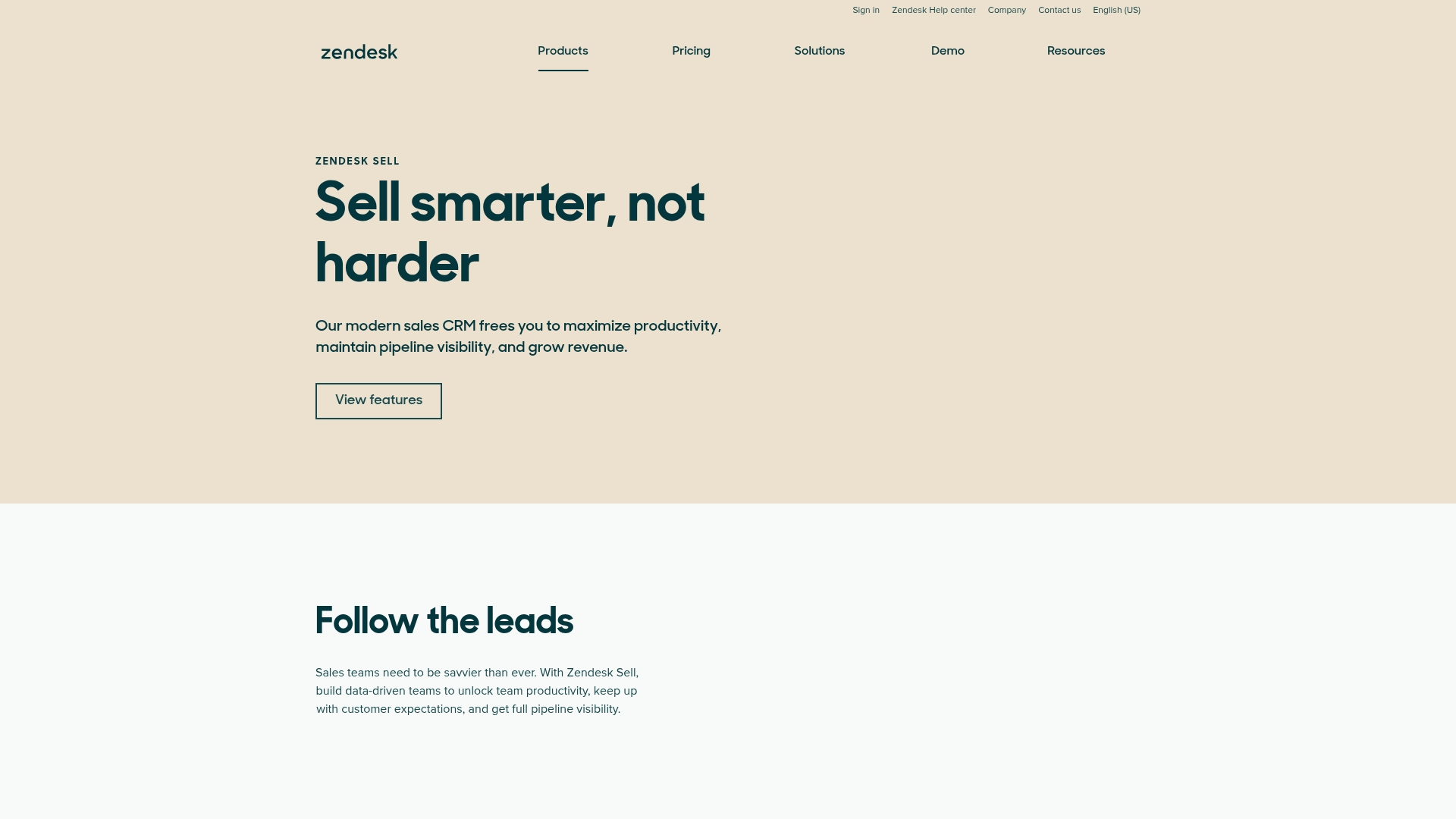 Use case:
Use case:
Zendesk Sell provides sales teams with intuitive reporting tools that combine sales and customer support data for a complete view of the customer journey.
Key features:
- Pre-built dashboards and customizable reports covering deals, leads, and call activity with over 20 chart types
- Pipeline and forecasting analysis with win likelihood percentages for accurate revenue predictions
- Real-time performance metrics including deal loss reasons, conversion rates, and individual rep performance tracking
Pricing:
Pricing information for Zendesk Sell is not publicly available on their main pricing page, which focuses on customer service products. Contact Zendesk directly for current Zendesk Sell pricing details.
Considerations:
- The platform will be discontinued on August 31st, 2027, making it unsuitable for long-term planning
- Advanced reporting features are restricted to higher-priced tiers, limiting functionality for budget-conscious teams
9. Phocas
Designed specifically for the manufacturing, distribution, and retail sectors, Phocas delivers self-service business intelligence and sales analytics. The platform specializes in making complex data accessible to non-technical users, empowering sales teams to analyze performance and forecast with confidence without relying on IT support.
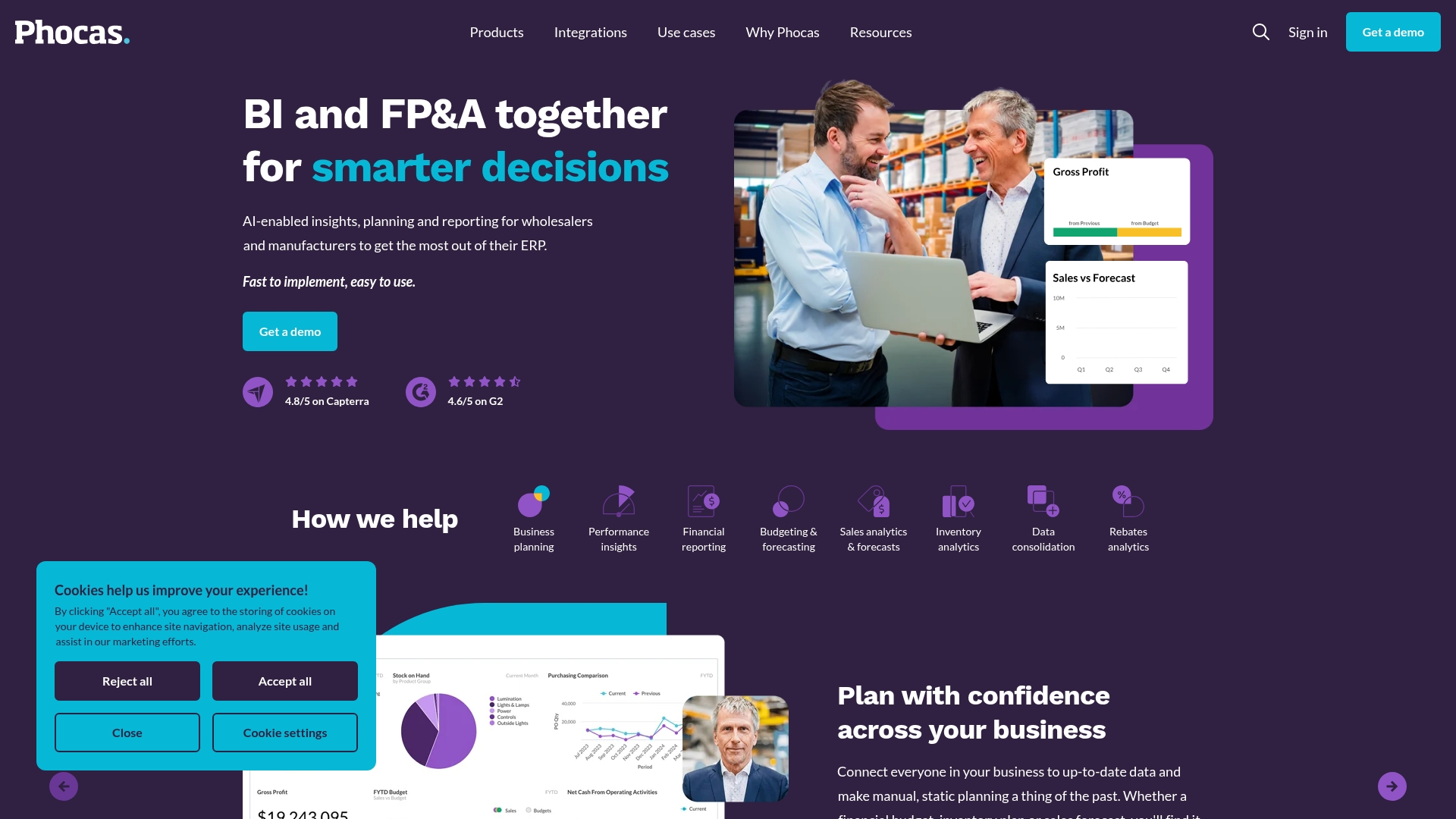 Use case:
Use case:
Phocas transforms sales data from ERPs and CRMs into actionable insights, enabling mid-market companies to track performance, identify trends, and make data-driven decisions without technical expertise.
Key features:
- Real-time sales analytics with drill-down capabilities from high-level summaries to transaction details
- AI-powered natural language queries that let users ask questions of their data in plain English
- Integrated forecasting tools that combine historical data, seasonal trends, and current performance metrics
Pricing:
Pricing information is not publicly available and requires contacting Phocas directly for a customized quote.
Considerations:
- Some users report a steep learning curve, particularly for those new to business intelligence software
- Data visualization options are considered less extensive compared to specialized tools like Tableau, with users requesting more advanced charting capabilities
10. Bigin by Zoho
Small businesses and startups seeking their first CRM beyond spreadsheets will find a pipeline-centric solution in Bigin by Zoho. The platform prioritizes simplicity and affordability, making it an excellent choice for teams that need to monitor performance without overwhelming complexity. Its intuitive dashboard system and visual sales tracking help growing businesses stay on top of their goals.
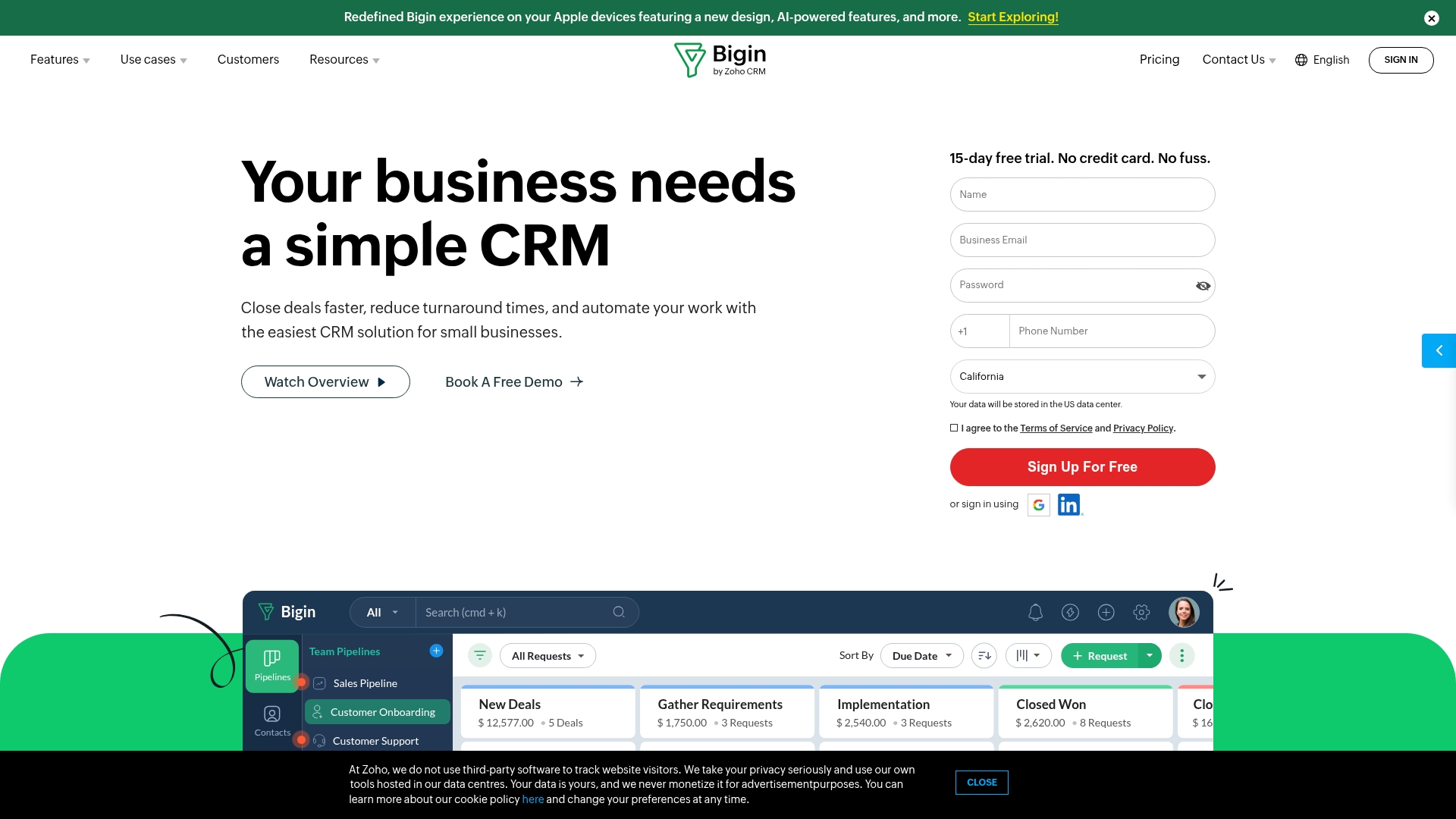 Use case:
Use case:
Bigin empowers small businesses and micro-enterprises to visualize sales performance through customizable dashboards and track team progress against goals using engaging visual indicators.
Key features:
- Pre-built and customizable dashboards with multiple chart types including pie, bar, funnel, and heatmap visualizations
- Target meter functionality with dial gauges, traffic lights, and progress bars to gamify goal tracking
- Dashboard drilldown capabilities that let users click into specific data points for detailed analysis
Pricing:
- Free: $0/month (1 user, 500 records)
- Express: $7/month annually or $9/month (unlimited users, 50,000 records)
- Premier: $12/month annually or $15/month (unlimited users, 100,000 records)
- Bigin 360: $18/month annually or $21/month (unlimited users, 1 million records)
- 15-day free trial available with no credit card required
- 30-day money-back guarantee for monthly plans, 45 days for annual subscriptions
Considerations:
- Native reporting capabilities are considered basic, with advanced features requiring an upgrade to Zoho Analytics
- Limited to viewing one pipeline at a time in reports, which can be restrictive for businesses with multiple sales processes
How to choose sales reporting software for your team
Selecting a new sales platform is a critical decision, but a structured approach can eliminate the guesswork. Here’s your checklist for finding the perfect fit:
- Map your current workflow: Document where your sales data lives today and identify where time is being lost in your reporting process.
- Involve your reps: Talk to the people who’ll use the system daily to uncover real friction points and understand how your team actually sells.
- Build your requirements list: Create a clear distinction between must-have features and nice-to-haves based on your team’s actual needs.
- Evaluate integrations: Check how seamlessly the platform connects with your existing tech stack. Platforms like monday CRM offer flexibility to build your ideal command center without starting from scratch.
- Test with real data: Run a pilot with your own messy, real-world data, because a demo environment never tells the whole story.
- Assess implementation speed: Look for a platform your team can adopt in days, not months, with an intuitive interface that means less downtime and more time selling.
- Consider long-term value: Check beyond the price tag to the true ROI. The visibility and control that help your team operate with greater speed and confidence.
- Get team buy-in: When your team genuinely enjoys using their tools, you know you’ve made the right choice.
More than a price tag: Finding your true ROI
Think of the right sales reporting software as an investment that compounds over time. When your team closes deals faster and forecasts with precision, the platform quickly pays for itself: then keeps delivering value quarter after quarter.
The best systems grow alongside your business. monday CRM adapts to your evolving needs, giving you exactly what you need today while staying flexible enough to support tomorrow’s ambitions. No artificial limits, no forced upgrades when you’re ready to scale.
The real value shows up in unexpected places: reps spending their days building relationships instead of updating spreadsheets, managers making confident decisions backed by real-time data, and entire teams moving in sync toward shared goals. That’s the ROI that matters: more wins, less friction, and a sales operation that actually enjoys the tools they use every day.
3 sales reporting trends reshaping revenue teams
Sales reporting has shifted from backward-looking spreadsheets to forward-thinking intelligence systems. Teams that once waited weeks for monthly reports now make decisions based on live data, and forecasts built on intuition have given way to AI-powered predictions. Here are three trends changing how revenue teams operate:
AI-driven revenue intelligence
Modern sales platforms use AI to surface patterns your team might overlook in day-to-day operations. Instead of manually reviewing every deal, AI flags which opportunities need attention, predicts close probability, and suggests next steps based on what’s worked before.
monday CRM’s AI features automate deal scoring and prioritization, so your reps know exactly where to focus their time. Ask questions in plain English (like “Which deals are at risk?“) and get instant answers that help you course-correct before it’s too late.
Real-time pipeline visibility
The gap between when something happens and when you know about it can cost you deals. Real-time dashboards eliminate that lag, giving your entire team instant visibility into pipeline changes as they occur.
When a deal stalls or a competitor enters the picture, you’ll know immediately. This means faster responses, better coordination between reps and managers, and fewer surprises at the end of the quarter. Everyone from marketing to leadership works from the same live dashboard, making decisions based on current reality rather than outdated snapshots.
Unified revenue operations platforms
Switching between separate tools for sales, marketing, and customer success creates blind spots. Information gets lost in handoffs, and teams waste time reconciling conflicting data from different systems.
Revenue teams are consolidating onto single platforms that track the entire customer journey in one place. Sales teams know exactly which marketing campaigns generate qualified leads, can help customer success identify upsell opportunities, and give leadership a complete view of revenue health. monday CRM delivers this naturally as part of the Work OS, connecting every customer touchpoint from first contact through renewal.
Try monday CRMWhy monday CRM leads in sales data software innovation
Great software should get out of your team’s way, not add more clicks and complexity. We built monday CRM to be that intuitive, single source of truth that helps your reps move faster and close deals with total confidence.
We put powerful automation and customization right at your fingertips, so you can build the exact sales machine you need without writing a single line of code. This gives your team back their most valuable resource: time.
The real magic, however, is how monday CRM unites your entire business on one platform. As part of the Work OS, we break down the silos between sales, marketing, and customer success, creating a single, aligned team that achieves its goals together.
FAQs about sales reporting tools
What types of sales reports can I create with reporting software?
You can create pipeline reports, conversion analysis, performance dashboards, and revenue forecasts. Platforms like monday CRM offer both pre-built templates and custom, drag-and-drop report builders.
How does sales reporting software integrate with existing CRM systems?
Most reporting tools connect to CRMs via APIs or pre-built connectors to sync data. A unified platform like monday CRM avoids integration entirely by having powerful reporting built directly into the CRM.
What's the difference between sales reporting and revenue intelligence software?
Sales reporting analyzes past performance, while revenue intelligence uses AI to predict future outcomes and recommend actions. Modern platforms are now combining both historical reporting and predictive insights into a single system.
How long does it take to implement sales reporting software?
Implementation can take anywhere from a few days to several weeks, depending on data complexity and integrations. Intuitive, cloud-based platforms with no-code setups offer the fastest path to getting your team up and running.
Can small teams benefit from sales reporting apps?
Yes, they provide small teams with automated data collection and crucial performance insights that are too time-consuming to generate manually.
What ROI can I expect from sales reporting software?
Most teams see ROI in 3–6 months from improved forecast accuracy, higher close rates, and less time spent on manual reporting. Real-time pipeline visibility enables faster, more strategic decision-making.
 Get started
Get started 

